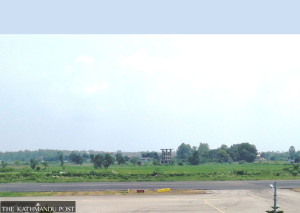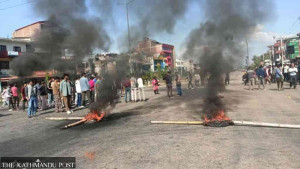National
How big—and widespread—is the Chand party? Depends who you ask.
It is not clear whether the Chand group has formed its own army—like the Maoists had during the insurgency days—but many believe it has hundreds, if not thousands, of weapons in its possession.
Tika R Pradhan
At a time when the KP Sharma Oli government has begun a manhunt for the leaders of the Netra Bikram Chand-led Communist Party of Nepal, one question looms large: just how strong—and widespread—is the party?
Addressing the closing session of Parliament on Sunday, Oli told lawmakers that the government has given a deadline for Chand’s CPN to surrender its weapons.
On Monday, while addressing a meeting of his Parliamentary Party, Oli maintained a tougher stance, saying “The Chand outfit will be brought to mainstream politics—if possible politically, and if not, by putting them behind bars.”
While the main opposition, Nepali Congress, has expressed concern over the way the government is dealing with the Chand outfit, saying such high-handed approach could sow the seeds of another conflict, security analysts have cautioned about a counteraction from the group.
It is not clear whether the Chand group has formed its own army—like the Maoists had during the insurgency days—but many believe it has hundreds, if not thousands, of weapons in its possession.
“Chand’s party not only has a sizeable number of weapons but also thousands of trained people,” said Balananda Sharma, a former Nepal Army official who was the coordinator of the Secretariat of the Special Committee to Supervise, Integrate and Rehabilitate the Maoist fighters.
Analysts say the Chand group seems to have been emboldened by the weapons it has, or else it would not have been able to extort people and demand donations up to Rs1 million from rural municipalities.
Two weeks ago Minister for Agriculture and Livestock Developments Chandra Prakash Khanal, who was a deputy commander of the Maoists’ now disbanded People’s Liberation Army, told reporters in Surkhet that Chand’s group may have some weapons in its possession because the rebels had taken some arms from all the 18 camps under six divisions of the People’s Liberation Army.
But Khanal is not the only former Maoist leader to have said that Chand’s cadres have weapons with them.
Even Nepal Communist Party (NCP) Co-chair Pushpa Kamal Dahal, former supreme commander of the Maoist army, had told reporters in Biratnagar on March 5 that some arms and ammunition were stolen from the cantonments and that “we had informed the government at the time about the incident.”
After the peace deal in 2006, Maoist fighters were boxed in seven cantonments across the country. The Post could not independently verify whether the Maoist party had reported the incident of weapons theft to the government.
Janardan Sharma, a former home minister and Maoist leader, however, said he was not aware of the incident. “You better ask Dahal,” he told the Post two days after Dahal’s statement.
When the Maoist army had stored their weapons in cantonments, as per the Agreement on Monitoring of the Management of Arms and Armies signed in 2006, the number had raised many eyebrows.
The rebel forces had stored 2,855 weapons in line with the agreement. Around 600 weapons were with the Maoist combatants for the security of cantonments and their leadership. Dahal had once even made light of a question related to the number of weapons, which was one-third of the number of fighters, saying “some were swept away by rivers”.
That the Chand party has not shown any sign of bowing down as yet is a cause for concern, security analysts say.
A day after Oli’s strong statement, the outfit on Tuesday issued a statement announcing its protest programmes, including a general strike on March 30 and nationwide demonstrations and assemblies on April 7.
Since the government declared the Chand party a “criminal and destructive” group and banned its activities on March 12, scores of its leaders, including a standing committee member and a politburo member, have been arrested.
But the party has defended its activities saying their fight is against fascism and the government. "While our party is gaining ground by taking action against anti-national elements, thugs, human traffickers and labour oppressors as per the public mandate, the government, in order to hide its failure, disrepute and crisis, has displayed a high level of fascism by imposing a ban on the party," reads the statement undersigned by Chand.
Security analysts wonder whether the statement is just a symbolic counter against the government’s tough stance or it indeed intends to launch a counter-attack.
“They have not resorted to attacking state mechanisms, but it’s obvious that they can if they are attacked. Chances of violence are high,” Sharma, the former Army official said. “It’s some sort of a trend that rebels who join peace processes tend to keep some weapons, as they harbour suspicion against the state authorities. During the insurgency, the Maoists did have some sophisticated weapons with them. Though we can’t say the number of weapons the Chand group may be possessing, they could have at least a few hundreds.”
Little is known about Chand’s party structure and organisation. Though Chand formed his own Communist Party of Nepal in 2014, party insiders told the Post the group started building its organisation and commands only two years ago.
Two years ago, when the outfit convened its national convention in Rolpa, party leaders said they had counted around 100,000 members and formed almost all the sister wings that its parent Maoist party had.
According to party leaders, the Communist Party of Nepal has its structures at most of the districts with four different commands—Eastern led by Anil Sharma, Central led by Hemanta Prakash Oli (arrested), Mid-western led by Santosh Budha and Western led by Dharmendra Bastola. However, the ‘security department’ is solely under party General Secretary Chand that includes former vice-commander of the Maoist army Udaya Bahadur Chalaune.
The party has also a formed people’s council led by its alternative standing committee member Santosh Budha Magar, who leads the “people’s governments” formed at the districts, according to Chand party leaders.
The Chand party in recent years is believed to have expanded its base in Kalikot, Rolpa and Kapilvastu, which is Chand’s hometown.
“Though the party has not formed its separate army, we have a significant number of former combatants, who are trained to use weapons,” Gunaraj Lohani, a central committee member of the Chand party, told the Post over the phone from an undisclosed location. “We have a sizeable number of combatants, most of whom were former Maoists, in the party’s security department and they can be turned into a formation any moment.”
Some believe Chand may have been getting some confidence, despite the arrests of his leaders, because of some opposition the government is facing for the way it deals with his party.
Legal and security experts told the Post last week that the country lacks the laws to deal with the Chand party the way the government wants.
Some leaders of Chand’s Communist Party of Nepal believe there are some differences between the assessments of the Nepal Army and Nepal Police when it comes to the outfit’s strength and a number of weapons they possess.
One of the advisers to Home Minister Ram Bahadur Thapa who refused to give his name said the Chand party neither has significant strength nor a military structure. “There may be some former disenchanted combatants with Chand,” he said.
Asked about the claims made by Oli that Chand would be arrested by mid-April, he said, “I wonder why the prime minister made such a claim. Maybe his statements are aimed at boosting the morale of security forces.”
Some sections of the intelligentsia and the opposition party have insisted that the government should try to persuade Chand to come to the negotiating table.
“It’s better if the Chand group joins the talks,” Sharma, the former army official said. “But I don’t think they would come so easily.”




 10.12°C Kathmandu
10.12°C Kathmandu













%20(1).jpg&w=300&height=200)

